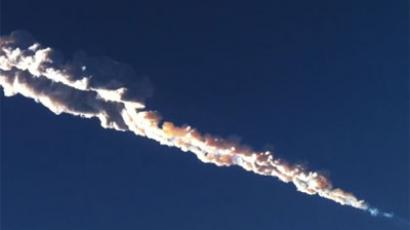Russian meteorite blast explained: Fireball explosion, not meteor shower

Russian scientists investigating the meteorite explosion in the Urals explained the nature of the event that caused havoc in the region. NASA said the shockwave force was equal to a 500-kiloton explosion – 30 times the Hiroshima blast.
The object was identified as a solitary 10-ton bolide by the Russian Academy of Sciences (RAN). Bolides, or bright fireballs, are large meteors that explode in the lower atmosphere, and unlike meteorite showers they can be dangerous, scientists explained.The Chelyabinsk fireball entered the atmosphere moving at a speed of about 20 km/s. The object, which was several meters in diameter, then burst into pieces at a height of 30-50 km above the ground, RAN reported.Three consecutive explosions shattered the meteorite further. Large fragments moving at a high speed caused a powerful flash and a strong shockwave, with most of its energy released at a height of 5 to 15 km above the earth, with the atmosphere absorbing most of that energy.NASA has increased its estimate of the energy released during the blast to nearly 500 kilotons of TNT. The calculations were based on the data from infrasound stations across the globe, some being over 6,500 kilometers away from Chelyabinsk. In comparison, the US atom bomb 'Little Boy' destroyed Hiroshima in 1945 with only 16 kilotons.
The impact and the sound of the blast reached the ground minutes after the explosion, causing havoc and panic in Chelyabinsk. While most of the object burned down during the fall, the remaining parts showered over the region, possibly adding to the damage and injuries.The actual power of the blast is still being discussed, with some scientists estimating it as low as 0.1 kilotons and others saying it could be nearly 500 kilotons, depending on the height the explosion was registered. Conflicting reports also centered on the trajectory of the falling body.The combustion products won’t stay in the atmosphere for long, and will soon come down with precipitation, Russian scientists said. The meteorite is believed to have caused no significant pollution, but the elements it emitted could only be identified after studying its fragments, they added. So far, RAN and Emergency services have denied the possibility of radioactive pollution.
Russian space agency Roscosmos earlier admitted they did not track the meteorite that fell near Chelyabinsk, although several other flybys were detected by Roshydromet overnight. “Our ground facilities and, as I understand, those abroad too did not monitor this celestial body,” the agency spokesman said.Astronomers around the globe didn’t notice the object coming either, and rushed in search of its traces on satellite images after the news spread.“Objects like that are nearly impossible to see until a day or two before impact,” Timothy Spahr of the Minor Planet Center in Cambridge, Massachusetts told Nature Magazine.Although the meteor was relatively small to detect, some argued its blast was comparable with the power of a nuclear bomb.According to Canadian astronomer Margaret Campbell-Brown, the blast could be even more powerful than North Korea’s recent nuclear test. Citing the data from two infrasound stations near the impact site, she estimated the object to be 15 meters in diameter with a mass of around 40 tons.“That would make it the biggest object recorded to hit the Earth since Tunguska,” Campbell-Brown told Nature Magazine.Most scientists both in Russia and abroad do not believe the Chelyabinsk bolide had anything to do with the asteroid 2012 DA14, which is expected to fly by just hours later.














